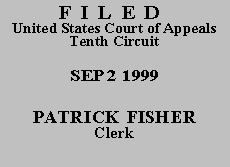

| JAMES R. FRANCIS,
Plaintiff-Appellant, v. KENNETH S. APFEL, Commissioner, Social Security Administration, Defendant-Appellee. |
|
Claimant James R. Francis appeals from the district court's(1) order affirming the decision of the Commissioner of Social Security. In that decision, the Commissioner denied claimant's applications for disability insurance benefits made under Title II of the Social Security Act. See 42 U.S.C. § 423. We exercise jurisdiction under 42 U.S.C. § 405(g) and 28 U.S.C. § 1291, and affirm.
Two issues are presented for review. The first is whether the administrative law judge's ("ALJ") determination that claimant's allegations of disabling pain and limitations were not fully credible is supported by substantial evidence. The second is whether the ALJ properly interpreted and considered the medical record and testimony in concluding that claimant is not disabled. In our review, we determine whether the ALJ's decision is supported by substantial evidence on the whole record and comports with relevant legal standards. See Casias v. Secretary of Health & Human Servs., 933 F.2d 799, 800-01 (10th Cir. 1991).
Claims for disability benefits are evaluated according to the five-step sequential process set out in 20 C.F.R. § 404.1520. See Williams v. Bowen, 844 F.2d 748, 750-52 (10th Cir. 1988). At step five of this process, the ALJ, with the assistance of a vocational expert, found that claimant maintained the residual functioning capacity to perform light work subject to restrictions on fully turning his neck and decreased left-hand gripping. He discredited claimant's subjective complaints of disabling pain, analyzing them in accordance with Luna v. Bowen, 834 F.2d 161 (10th Cir. 1987).
Claimant's application for disability benefits is based on a very narrow window of timefrom January 1, 1989, which is the date claimant alleges his disability began, to June 30, 1989, when claimant's insured status expired and disability had to be established. As the district court noted, plaintiff presented no medical records covering this time frame, so the ALJ had to make inferences from medical records generated after that date. On appeal, claimant's major objections are addressed to what he characterizes as the ALJ's misstatements of the medical record and of his testimony. The district court fully considered, addressed, and rejected these arguments, and claimant does not explain why the district court's findings and conclusions are erroneous except to reiterate the objections he made to that court.
We particularly agree with the district court that the absence of a medical record during the period of alleged disability together with notations in records made in 1993 support a strong inference that claimant's physical problems apparently did not become severe until 1990 or later, when he sought medical intervention. See Appellant's App. at 261-62 (district court order affirming Commissioner's decision). We have carefully reviewed the entire medical record, the parties' arguments, and the relevant law. For substantially the same reasons as set forth in the district court's order filed July 30, 1998, we conclude that the Commissioner's decision is supported by substantial evidence on the whole record and comports with the relevant legal standards.
The judgment of the United States District Court for the Northern District of Oklahoma is AFFIRMED.
Entered for the Court
Circuit Judge
*. This order and judgment is not binding precedent, except under the doctrines of law of the case, res judicata, and collateral estoppel. The court generally disfavors the citation of orders and judgments; nevertheless, an order and judgment may be cited under the terms and conditions of 10th Cir. R. 36.3.
1. The parties consented to proceed before a United States Magistrate Judge. See 28 U.S.C. § 636(c)(1) & (3).